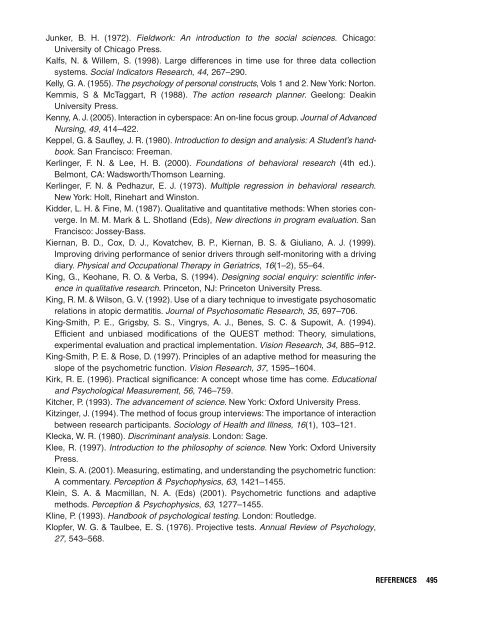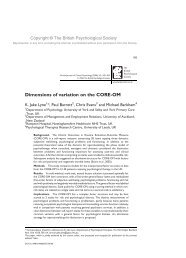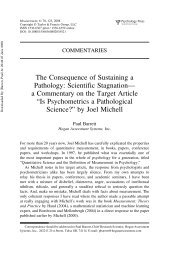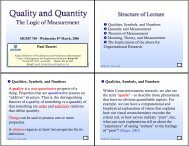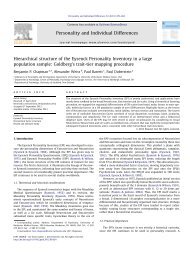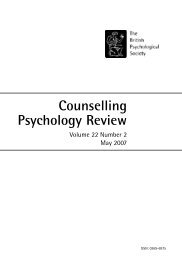Psychophysiological Methods - Paul Barrett
Psychophysiological Methods - Paul Barrett
Psychophysiological Methods - Paul Barrett
- No tags were found...
Create successful ePaper yourself
Turn your PDF publications into a flip-book with our unique Google optimized e-Paper software.
Breakwell-3389-Reference.qxd 2/7/2006 9:03 PM Page 495Junker, B. H. (1972). Fieldwork: An introduction to the social sciences. Chicago:University of Chicago Press.Kalfs, N. & Willem, S. (1998). Large differences in time use for three data collectionsystems. Social Indicators Research, 44, 267–290.Kelly, G. A. (1955). The psychology of personal constructs, Vols 1 and 2. New York: Norton.Kemmis, S & McTaggart, R (1988). The action research planner. Geelong: DeakinUniversity Press.Kenny, A. J. (2005). Interaction in cyberspace: An on-line focus group. Journal of AdvancedNursing, 49, 414–422.Keppel, G. & Saufley, J. R. (1980). Introduction to design and analysis: A Student’s handbook.San Francisco: Freeman.Kerlinger, F. N. & Lee, H. B. (2000). Foundations of behavioral research (4th ed.).Belmont, CA: Wadsworth/Thomson Learning.Kerlinger, F. N. & Pedhazur, E. J. (1973). Multiple regression in behavioral research.New York: Holt, Rinehart and Winston.Kidder, L. H. & Fine, M. (1987). Qualitative and quantitative methods: When stories converge.In M. M. Mark & L. Shotland (Eds), New directions in program evaluation. SanFrancisco: Jossey-Bass.Kiernan, B. D., Cox, D. J., Kovatchev, B. P., Kiernan, B. S. & Giuliano, A. J. (1999).Improving driving performance of senior drivers through self-monitoring with a drivingdiary. Physical and Occupational Therapy in Geriatrics, 16(1–2), 55–64.King, G., Keohane, R. O. & Verba, S. (1994). Designing social enquiry: scientific inferencein qualitative research. Princeton, NJ: Princeton University Press.King, R. M. & Wilson, G. V. (1992). Use of a diary technique to investigate psychosomaticrelations in atopic dermatitis. Journal of Psychosomatic Research, 35, 697–706.King-Smith, P. E., Grigsby, S. S., Vingrys, A. J., Benes, S. C. & Supowit, A. (1994).Efficient and unbiased modifications of the QUEST method: Theory, simulations,experimental evaluation and practical implementation. Vision Research, 34, 885–912.King-Smith, P. E. & Rose, D. (1997). Principles of an adaptive method for measuring theslope of the psychometric function. Vision Research, 37, 1595–1604.Kirk, R. E. (1996). Practical significance: A concept whose time has come. Educationaland Psychological Measurement, 56, 746–759.Kitcher, P. (1993). The advancement of science. New York: Oxford University Press.Kitzinger, J. (1994). The method of focus group interviews: The importance of interactionbetween research participants. Sociology of Health and Illness, 16(1), 103–121.Klecka, W. R. (1980). Discriminant analysis. London: Sage.Klee, R. (1997). Introduction to the philosophy of science. New York: Oxford UniversityPress.Klein, S. A. (2001). Measuring, estimating, and understanding the psychometric function:A commentary. Perception & Psychophysics, 63, 1421–1455.Klein, S. A. & Macmillan, N. A. (Eds) (2001). Psychometric functions and adaptivemethods. Perception & Psychophysics, 63, 1277–1455.Kline, P. (1993). Handbook of psychological testing. London: Routledge.Klopfer, W. G. & Taulbee, E. S. (1976). Projective tests. Annual Review of Psychology,27, 543–568.REFERENCES495


